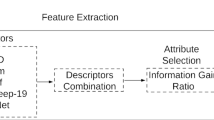Abstract
In this paper, we split the region of interest of dermoscopic images of skin lesions in patches of different size and we analyze the impact of the entropy of the patches on patch-based binary classification using a convolutional neural network (CNN). Specifically, we analyze the distribution of entropy amongst the patches and we compare the training time of a classifier on subsets of the data with varying entropy. We find that the classifier converges faster on patches with higher entropy. Our entropy-based analysis is performed on skin lesion images from the ISIC archive.
Access this chapter
Tax calculation will be finalised at checkout
Purchases are for personal use only
Similar content being viewed by others
Notes
- 1.
The data is publicly available at https://www.isic-archive.com.
- 2.
- 3.
Originally, the ISIC challenge had more refined categories. In this paper we use only 2.
References
Anwar, S.M., Majid, M., Qayyum, A., Awais, M., Alnowami, M., Khan, M.K.: Medical image analysis using convolutional neural networks: a review. J. Med. Syst. 42(11), 1–13 (2018). https://doi.org/10.1007/s10916-018-1088-1
Esteva, A., Kuprel, B., Novoa, R.A., Ko, J., Swetter, S.M., Blau, H.M., Thrun, S.: Dermatologist-level classification of skin cancer with deep neural networks. Nature 542(7639), 115–118 (2017). https://doi.org/10.1038/nature21056
Favole, F., Trocan, M., Yilmaz, E.: Melanoma detection using deep learning. In: Nguyen, N.T., Hoang, B.H., Huynh, C.P., Hwang, D., Trawiński, B., Vossen, G. (eds.) ICCCI 2020. LNCS (LNAI), vol. 12496, pp. 816–824. Springer, Cham (2020). https://doi.org/10.1007/978-3-030-63007-2_64
Gessert, N., Nielsen, M., Shaikh, M., Werner, R., Schlaefer, A.: Skin lesion classification using ensembles of multi-resolution EfficientNets with meta data. MethodsX 7, 100864 (2020). https://doi.org/10.1016/j.mex.2020.100864
Gessert, N., et al.: Skin lesion classification using CNNs with patch-based attention and diagnosis-guided loss weighting. IEEE Trans. Biomed. Eng. 67(2), 495–503 (2020). https://doi.org/10.1109/TBME.2019.2915839
Glorot, X., Bengio, Y.: Understanding the difficulty of training deep feedforward neural networks. In: Teh, Y.W., Titterington, D.M. (eds.) Proceedings of the Thirteenth International Conference on Artificial Intelligence and Statistics, AISTATS 2010, Chia Laguna Resort, Sardinia, Italy, 13–15May 2010. JMLR Proceedings, vol. 9, pp. 249–256. JMLR.org (2010)
Gutman, D., et al.: Skin Lesion Analysis toward Melanoma Detection: A Challenge at the International Symposium on Biomedical Imaging (ISBI) 2016, hosted by the International Skin Imaging Collaboration (ISIC). arXiv:1605.01397 [cs] (May 2016)
He, K., Zhang, X., Ren, S., Sun, J.: Deep Residual Learning for Image Recognition. In: 2016 IEEE Conference on Computer Vision and Pattern Recognition (CVPR), Las Vegas, NV, USA, pp. 770–778. IEEE (2016). https://doi.org/10.1109/CVPR.2016.90
Hou, L., Samaras, D., Kurc, T.M., Gao, Y., Davis, J.E., Saltz, J.H.: Patch-based convolutional neural network for whole slide tissue image classification. In: 2016 IEEE Conference on Computer Vision and Pattern Recognition (CVPR), pp. 2424–2433 (2016). https://doi.org/10.1109/CVPR.2016.266
Kingma, D.P., Ba, J.: Adam: a method for stochastic optimization. CoRR abs/1412.6980 (2015)
Marentakis, P., et al.: Lung cancer histology classification from CT images based on radiomics and deep learning models. Med. Biol. Eng. Comput. 59(1), 215–226 (2021). https://doi.org/10.1007/s11517-020-02302-w
Nigam, K., Lafferty, J., McCallum, A.: Using maximum entropy for text classification. In: IJCAI-99 Workshop on Machine Learning for Information Filtering, Stockholom, Sweden, vol. 1, pp. 61–67 (1999)
Ouchtati, S., Chergui, A., Mavromatis, S., Aissa, B., Rafik, D., Sequeira, J.: Novel method for brain tumor classification based on use of image entropy and seven hu’s invariant moments. Traitement du Signal 36(6), 483–491 (2019). https://doi.org/10.18280/ts.360602
Ritchie, H., Roser, M.: Causes of death. In: Our World in Data (2018)
Rotemberg, V., et al.: A patient-centric dataset of images and metadata for identifying melanomas using clinical context. Sci. Data 8(1), 34 (2021). https://doi.org/10.1038/s41597-021-00815-z
Rousseau, F., Habas, P.A., Studholme, C.: A supervised patch-based approach for human brain labeling. IEEE Trans. Med. Imaging 30(10), 1852–1862 (2011). https://doi.org/10.1109/TMI.2011.2156806
Roy, K., Banik, D., Bhattacharjee, D., Nasipuri, M.: Patch-based system for classification of Breast Histology images using deep learning. Comput. Med. Imaging Graph. 71, 90–103 (2019). https://doi.org/10.1016/j.compmedimag.2018.11.003
Shannon, C.E.: A mathematical theory of communication. Bell Syst. Tech. J. 27(3), 379–423 (1948). https://doi.org/10.1002/j.1538-7305.1948.tb01338.x
Siegel, R.L., Miller, K.D., Fuchs, H.E., Jemal, A.: Cancer statistics. CA Cancer J. Clin. 71(1), 7–33 (2021). https://doi.org/10.3322/caac.21654
Skilling, J., Bryan, R.: Maximum entropy image reconstruction-general algorithm. Mon. Not. R. Astron. Soc. 211, 111 (1984)
Tschandl, P., Rosendahl, C., Kittler, H.: The HAM10000 dataset, a large collection of multi-source dermatoscopic images of common pigmented skin lesions. Sci. Data 5(1), 180161 (2018). https://doi.org/10.1038/sdata.2018.161
Yala, A., Lehman, C., Schuster, T., Portnoi, T., Barzilay, R.: A deep learning mammography-based model for improved breast cancer risk prediction. Radiology 292(1), 60–66 (2019). https://doi.org/10.1148/radiol.2019182716
Yilmaz, E., Trocan, M.: Benign and malignant skin lesion classification comparison for three deep-learning architectures. In: Nguyen, N.T., Jearanaitanakij, K., Selamat, A., Trawiński, B., Chittayasothorn, S. (eds.) ACIIDS 2020. LNCS (LNAI), vol. 12033, pp. 514–524. Springer, Cham (2020). https://doi.org/10.1007/978-3-030-41964-6_44
Zhang, F., et al.: Lung nodule classification with multilevel patch-based context analysis. IEEE Trans. Biomed. Eng. 61(4), 1155–1166 (2014). https://doi.org/10.1109/TBME.2013.2295593
Zhu, S.C., Wu, Y.N., Mumford, D.: Minimax entropy principle and its application to texture modeling. Neural Comput. 9(8), 1627–1660 (1997). https://doi.org/10.1162/neco.1997.9.8.1627
Author information
Authors and Affiliations
Corresponding authors
Editor information
Editors and Affiliations
Rights and permissions
Copyright information
© 2021 Springer Nature Switzerland AG
About this paper
Cite this paper
Lachaud, G., Conde-Cespedes, P., Trocan, M. (2021). Entropy Role on Patch-Based Binary Classification for Skin Melanoma. In: Wojtkiewicz, K., Treur, J., Pimenidis, E., Maleszka, M. (eds) Advances in Computational Collective Intelligence. ICCCI 2021. Communications in Computer and Information Science, vol 1463. Springer, Cham. https://doi.org/10.1007/978-3-030-88113-9_26
Download citation
DOI: https://doi.org/10.1007/978-3-030-88113-9_26
Published:
Publisher Name: Springer, Cham
Print ISBN: 978-3-030-88112-2
Online ISBN: 978-3-030-88113-9
eBook Packages: Computer ScienceComputer Science (R0)




